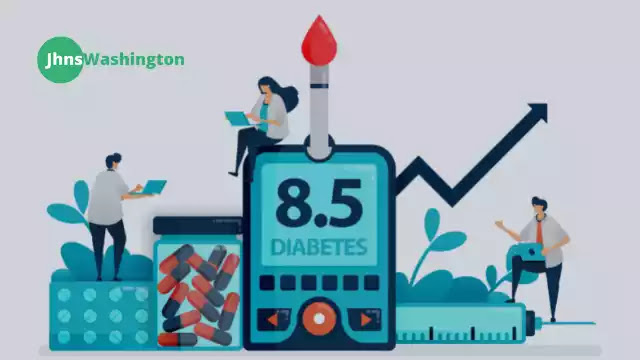Diabetes refers to diseases that affect how the body uses blood sugar (glucose). Glucose is essential to your health because it is an important energy source for the cells that make up your muscles and tissues. It is also the brain's primary energy source.
The underlying cause of diabetes varies by type. But, no matter what type of diabetes you have, it can lead to increased sugar in your blood. A high sugar concentration in your blood could lead to serious health issues.

Cases of chronic diabetes mellitus include Type I diabetes mellitus and Type II diabetes mellitus. Treatment for diabetes-related conditions includes gestational diabetes and prediabetes.
Prediabetes occurs when your blood sugar level is higher than usual but not high enough to be classified as diabetes. Prediabetes is often a precursor of diabetes unless appropriate measures prevent it from getting worse. Gestational diabetes occurs during pregnancy but may heal after delivery.
Diabetes symptoms
The signs of diabetes can vary based on blood sugar level. Certain people, specifically those who suffer from prediabetes, also known as Type 2 Diabetes, may not show any symptoms.
When it's type 1 diabetes, symptoms can develop quickly and be more severe.
Here are some symptoms and signs of type 1 and type 2 diabetes:
- Extreme thirst.
- Frequent urination.
- Feeling very hungry.
- Unexplained weight loss.
- Presence of ketones in the urine (ketones are a byproduct of the breakdown of muscle and fat that occurs when there is not enough insulin available).
- Fatigue.
- Ease of arousal.
- Blurred vision.
- Sores are slow to heal.
- Frequent infections, such as skin infections or vaginal infections.
- Type 1 diabetes can develop at any age, although it often starts in childhood or adolescence.
- Type 2 diabetes, the most common type, can develop at any age, although more common in people over 40.
Diabetes causes
- Insulin is a hormone that comes from a gland behind and under the stomach (the pancreas).
- The pancreas secretes insulin into the blood.
- Insulin travels with your circulation, allowing sugar to enter your cells.
- Insulin reduces the amount of sugar in your bloodstream.
- As your blood sugar levels drop, insulin secretion by your pancreas also decreases.
- Glucose, a type of sugar, is a major source of energy from which cells form muscles and other tissues.
- Glucose is derived from two primary sources: food and the liver.
- Sugar is absorbed by the bloodstream and is absorbed into cells with the aid of insulin.
- Your liver stores and creates glucose.
- If your blood sugar is low, for instance, if you've not eaten for a while, your liver converts glycogen into glucose to maintain your blood sugar levels within the normal level.
Causes of type 1 diabetes
The reason for the onset of the cause of type 1 diabetes isn't known. It is known that your immune system usually combats harmful viruses and bacteria fights and destroys insulin-producing cells within the pancreas.
The body is no less insulin. Instead of getting into cells, the sugar accumulates within the bloodstream.
There is a belief that the root cause of type 1 diabetes is a mix of genetic predispositions and environmental influences.
However, it isn't known which of these causes are. Weight is not likely to be a contributing factor in type 1 diabetes.
Causes of prediabetes and type 2 diabetes
In prediabetes, which could lead to type 2 diabetes or type 2 diabetes, the cells become intolerant to the action of insulin.
The pancreas is not able to make enough insulin to beat this resistance. Instead of the sugar flowing to the cells that require energy, it is stored in the bloodstream.
The exact cause isn't identified, but environmental and genetic elements are believed to be involved in developing Type 2 Diabetes, too.
Being overweight is strongly linked with diabetes type 2; however, not every person with type 2 diabetes is fat.
Causes of gestational diabetes
During pregnancy, the placenta releases hormones to help you maintain your pregnancy.
The hormones in your body make your cells more substantial and more resistant to insulin.
In general, your pancreas releases more insulin to counteract this resistance.
However, the pancreas may not cope with the demands. If this occurs, less glucose is entering the cells, but more is left in your bloodstream, resulting in gestational diabetes.
Risk factors for type 2 diabetes

Family history: Your risk increases if your parents or siblings have type 1 diabetes.
Environmental factors: Conditions such as exposure to a viral disease may play a role in type 1 diabetes. Presence of destroyed cells in the immune system (self-antigens). Sometimes family members of people with type 1 diabetes are tested for glucose self-antigens. If you have these autoantigens, you are more likely to develop type 1 diabetes. But not everyone who has these autoantigens develops diabetes.
Geography: Certain countries, such as Finland and Sweden, have higher rates of type 1 diabetes.
Factors that increase the risk of prediabetes as well as type 2 diabetes
Researchers cannot fully comprehend why certain people get prediabetes or type 2 diabetes while other people don't. However, it is clear that some factors increase the risk of infection, including:
Weight: The more fat in your tissues, the more resistant your cells are to insulin.
Lack of activity (lethargy): The less active you are, the higher your risk. Physical activity helps you control your weight, as it uses glucose as energy and makes your cells more sensitive to insulin.
Family history: Your risk is higher when one of your siblings or parents has type 2 diabetes.
Ethnicity or origin Although the cause isn't clear: Some people are at higher risk, including blacks, Hispanics, American Indians, and Asian Americans.
Age: Your risk increases as you get older. This may be because you tend to exercise less and lose muscle mass and gain weight as you get older. However, type 2 diabetes is also rising in children, adults, and young adults.
Gestational diabetes: If you developed gestational diabetes when you were pregnant, you would have an increased risk of developing prediabetes and type 2 diabetes later. If you gave birth to a baby who weighed more than 9 pounds (4 kilograms), you are also at risk of developing type 2 diabetes.
Polycystic ovary syndrome: Women with polycystic ovary syndrome a common condition characterized by irregular menstrual periods, increased hair growth, and obesity have an increased risk of diabetes.
High blood pressure: Blood pressure greater than 140/90 millimeters of mercury (mm Hg) is associated with an increased risk of type 2 diabetes.
Abnormal cholesterol and triglyceride levels: If you have low levels of high-density lipoprotein (HDL) or "good" cholesterol, your risk of developing type 2 diabetes is higher. Triglycerides are different kinds of fat that are transported in the bloodstream. People with high triglycerides have an increased risk of developing type 2 diabetes. Your doctor can tell you how much cholesterol and triglyceride levels you have.
Diabetes prevention and control
Type 1 diabetes can't be prevented. However, the same healthy lifestyle choices that aid in treating prediabetes type 2 diabetes, prediabetes, and gestational diabetes may also assist in preventing them.
Eat nutritious foods. Select food items with lower calories and fats and are high in fiber. Make sure you are eating fruits, vegetables as well as whole grains. Be sure to have plenty of variety to avoid getting bored.
Engage in more physical activity. Perform 30 minutes of moderate-intensity aerobic exercise regularly throughout the week. Or achieve 150 minutes of moderate-intensity aerobic activity per week.
Lose excessive weight. If you're overweight, you can reduce the risk of developing diabetes by losing 7 percent or more body fat. For example, you can lose 14 pounds (6.4 kilograms) when you weigh 200 pounds (90.7 kilograms).
But don't try to shed some weight during your pregnancy. Consult your physician regarding the right weight increase during pregnancy.
To keep your weight in the healthy range, you must focus on making permanent modifications to your eating and exercise routine. Remind yourself of the advantages that weight loss brings, like better health for your heart, increased energy, and confidence in yourself.
Sometimes, medications are also an alternative. Oral diabetes medications, such as metformin (Glumetza, Fortamet, others), can reduce the risk of having type 2 diabetes, but the importance of a healthy lifestyle is still paramount. Your blood sugar levels should be monitored every year, at a minimum, to ensure that you don't have diabetes of type 2.
